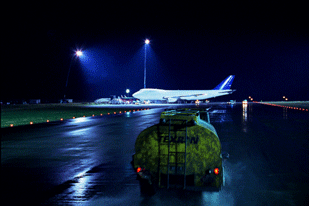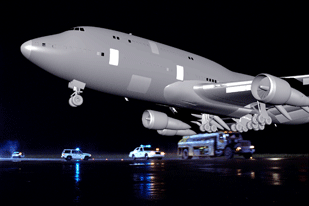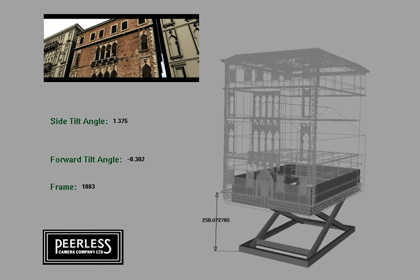Alain Bielik goes behind the scenes of how Peerless Camera provided seamless vfx for 007's first assignment in Casino Royale.

For more than 30 years, the James Bond franchise almost exclusively relied on elaborate practical and miniature effects to shoot their most spectacular action sequences. However, when Pierce Brosnan took over as secret agent 007 in 1995, the saga progressively incorporated digital effects into its arsenal. This approach reached a high point with Die Another Day (2002), a movie that featured an invisible car, 007 surfing a tsunami, a high tech satellite and a destructive energy beam. Way too much, according to most reviewers. Even though Die Another Day ended up being the highest grossing Bond movie ever, producers Michael G. Wilson and Barbara Broccoli embraced a more back to basics approach with Casino Royale (Columbia Pictures/MGM, Nov. 17), based on Ian Fleming's first novel. The gamble has since paid off beyond expectation along with the controversial signing of Daniel Craig as 007, as Casino Royale has topped Die Another Day as the all-time franchise hit with more than $500 million worldwide.
For this origin story, director Martin Campbell wanted to limit the use of digital effects to an absolute minimum, bringing the franchise back to its hard edge, low-tech From Russia With Love days.
To this purpose, they enlisted visual effects supervisor Steve Begg, a seasoned expert in miniature effects (Batman Begins). The results are so impressive that Casino Royale has been shortlisted for a VFX Oscar. "When I came in, the original idea was to do as much in-camera as possible. This, of course, is not exactly what happened. They had initially planned for about 60/80 digital vfx shots, but I knew this would go up in post-production. Well, it eventually went up to 580 shots. Still, there was a lot of traditional model work featured in the film, and the stunt work was all for real, albeit assisted by wire and rig removal."
The visual effects were originally all assigned to Peerless Camera Co., a London-based vendor that had provided digital trickery for Legend of Zorro, Campbell's previous directorial effort. When the shot count grew substantially, Begg and visual effects producer Sharon Lark brought several other British vendors in. In the end, six facilities worked on the project:
Peerless Camera Co.: 430 shotsDouble Negative: 50 shotsCinesite: 30 shotsThe Moving Picture Co. (MPC): 20 shotsBase Black: 20 shotsFuzzy Goat: 20 shots
The extensive physical effects were created by Bond veteran Chris Corbould, while the model work was directed by Begg.
Creating a Sense of Danger
The movie opens with an extensive chase sequence in which Bond runs after a terrorist in a construction site. Both end up fighting on a crane arm, high above the ground. In the first part of the sequence, the terrorist is seen watching a fight between a cobra and a mongoose. The two animals were shot separately on greenscreen, with animal wranglers trying to get an appropriate performance, and then composited together in a clean background plate by MPC. For the chase itself, the stunt team used many different rigs, cables, harnesses and airbags that all had to be hand-painted out by very patient artists at Peerless Camera... The team there included president and visual effects consultant Kent Houston, visual effects supervisor John Paul Docherty and digital effects producers Diane Kingston and Marianne Speight. Some of these shots proved to be very challenging.

"There was one moving helicopter shot, in particular, in which the camera was circling the action with water in the background," head of CG Ditch Doy recounts. "During this shot, the characters make a huge jump from one crane arm to another. The stunt was performed for real, but both stunt doubles wore a safety harness that was connected to a third crane that was sitting in the middle of the frame. Our 2D artists had to remove the crane and painstakingly reconstruct the background, and the water, as there was no clean plate available. We also had to do some 3D work to create a proper perspective change on background rooftops that had been obstructed by the third crane. It was a huge endeavor. Our artists did a brilliant job and the shot looks amazing."
Tighter shots on the crane arm fight were photographed on a partial set built on a rooftop, as to provide an aerial perspective in camera. In many instances, Peerless digitally extended the crane arm, and also created a ground view. "For safety reasons, we could never take a clean plate of the entire ground," Doy adds. "We always had the base of the crane in the frame. So, in order to build the ground, we had to patch various pieces of background plates together. Whenever this 2D approach didn't work, we used a 2½D option. We also built several 3D buildings to extend the construction site and create the appropriate perspectives." For this type of work, Peerless Camera mainly used Maya associated with mental ray. All the shots were composited in Shake and Inferno.
Creating an Airport in the Computer
The next big action sequence involves a car chase at Miami airport where a terrorist is trying to blow up a new airplane that is being introduced to the medias. The sequence was mainly shot at night at an abandoned Royal Air Force airfield. Since the location was situated in the countryside, there was no human activity anywhere around, which translated into pitch-black backgrounds--hardly suitable for nighttime Miami. Therefore, Peerless was asked to create a busy urban environment for the entire sequence, also adding extra hangars and terminal buildings to the airfield to turn it into an international airport.

"Using the Panavision Genesis digital camera, Begg went to the Miami airport and shot background footage of the area," Doy says. "We used this material either as reference for our mattepaintings, or in some occasions, as an element that we dropped directly in the background of our airfield plates. Matte painter Jim Bowers used Photoshop to created a series of four very large 12,000 lines matte paintings that, once put together, represented the whole environment. We never used them all together though, as the action moves to different locations of the airport. Jim built the paintings in layers: far horizon, distant buildings, nearest hangars, which allowed us to create a multiplane effect and get a sense of depth. The buildings were actually modeled in 3D, but used as 2D elements, a technique that Jim uses to quickly create several different angles." The airfield was also populated with a great number of people running around. Most of them were extras shot on greenscreen, but in longer shots, Doy and his team employed SOFTIMAGE | XSI's Behavior to create CG extras. They were animated using motion captured run cycles that were dug out from Peerless archives.
In order to create the feel of a busy international airport, a lot of moving air traffic lights had to be added in. Most of these lights were 3D animations created by Peerless, but Begg also bought some off-the shelf airplane desktop model kits that were equipped with high intensity LEDs. "We shot them against black and Peerless dropped them in the background," Begg says. "It allowed us to limit the use of 3D animation to a minimum. One of these kits, a 14-inch long Boeing 747, actually appears in three shots, landing right behind James Bond. With high intensity LED lights and hand-animated anti-collision lights, it works beautifully. I like this kind of mixture of low tech and high tech." Adds Doy, "We added moving lights in every shot, both on the ground and in the air. We did this using Maya and, in some cases, by animating 2D lights in Shake directly."
Digital Makeover
Key to the sequence, the prototype airplane was created from scratch by the art department. It was built as a 1/12-scale miniature that was shot motion control on a smoked stage in front of a miniature hangar. For shots that couldn't be achieved with the practical model, Begg opted to shoot live action plates with a real Boeing 747. The airplane was then digitally enhanced by Peerless Camera. "We first built a CG replica based on the practical model, using Maya for modeling and animation, and mental ray for rendering," Doy explains. "The trick there was to be able to track such a huge object. We had to nail it down 100% as, in most of the shots, the top part of the airplane would be our CG model, and the bottom part would be the real aircraft. These two elements had to move and look like one single object, which was no easy task. Mark Spevick, our tracking supervisor, did a great job of tracking this gigantic airplane using SynthEyes.
"The other challenge was to match the texture of the real airplane in order for the CG part to completely blend in. On location, we took high dynamic range photographs of a chrome sphere with bracketed exposures. There was no need to actually capture the environment itself as they were using massive floodlights that were easy to locate in 3D space with the chrome sphere. The most difficult part here was to blend the CG texture in the real surface. Since there was no hard edge on the airplane where we could hide the joints, we had to rely on our shader to create a perfect blend. In terms of the textures, we took hundreds of photographs both of the model and the live action 747. These images were then used as texture maps that were combined with paintwork. In action shots involving near misses with the terrorist-driven vehicle, the airplane was totally computer-generated. That was another challenge as our CG model had to be composited in live-action plates featuring real airplanes..."
During the course of the car chase, a police car is caught in the jet wash of an incoming 747 and gets blasted across the runway. The stunt was shot with a special rig that catapulted the car in the air. Peerless later painted the rig out and created a CG car to replace the stunt car in the very beginning of the shot, just to get more realistic dynamics for the "take-off." The car was modeled and animated in XSI, then imported into Maya to be shaded and rendered in mental ray. Entirely digital, the 747 was created in Maya and mental ray using the photographic reference and the measurements that had been taken on the live-action airplane to build the prototype aircraft.
"This sequence was a mixture of absolutely everything," Doy notes. "We had a 2D horizon, 2½D airport environments, CG terminals, real hangars, CG hangars, plus the lead miniature hangar, airplane models, half CG/half live-action airplane, full 3D airplanes, greenscreen extras, CG extras... all mixed up with highly kinetic live-action footage. So, it became a huge challenge to make it look like all these separate elements had been shot at the same time."
Sinking Buildings
In another major action sequence later on, a whole villa ends up collapsing into the Grand Canal in Venice, Italy. Due to the scale of the event, the sequence was previsualized by Peerless in Maya. The animation helped determine what could be done practically, how large the set and the tank needed to be and the kind of motion rig that was required. "I went to Venice to shoot background plates with 150 extras and practical water effects in the Grand Canal to simulate the collapse of the villa," Begg says. "Then, part of the collapse was shot full scale with a four stories high set built in a water tank on top of a massive computer controlled scissor lift. Peerless digitally added debris, dust and dirt to these shots, as we didn't want to run the risk of having the dust cover the action while we were shooting.
"Then, for longer shots, we built a 1/3-scale miniature representing the villa, the building behind it, and the two adjacent mansions. The reason for building these two buildings was that I didn't want to have to rotoscope a whole cloud of dust and debris to incorporate the model footage into live-action plates. The miniature set was then dropped in right in the middle of the Venice footage and carefully blended in." Water always being an issue in model work, Peerless polished the shots by adding several layers of full size debris that Begg had shot falling into a water tank against black. Other debris and dust elements were gathered from Peerless archives.
Keeping a Low VFX Profile
In the end, the back to basics approach of Casino Royale turned out to be a huge visual effects challenge, even more so because the producers absolutely required that the digital work remain unnoticed. For everyone involved, this movie was as sophisticated as the previous outing, but for audiences worldwide, it had to look like a refreshing return to the origins of the saga. Mission accomplished, 007. James Bond Will Return!
Alain Bielik is the founder and editor of renowned effects magazine S.F.X, published in France since 1991. He also contributes to various French publications and occasionally to Cinefex. Last year, he organized a major special effects exhibition at the Musée International de la Miniature in Lyon, France.









